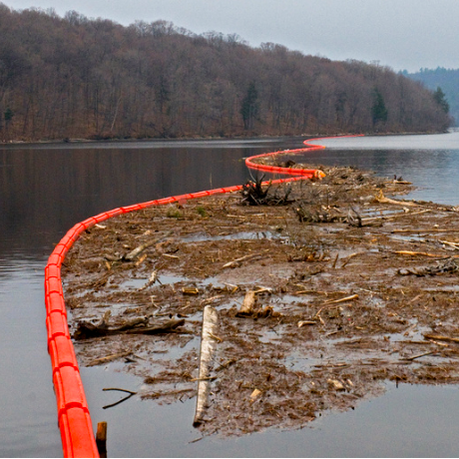A
Annual Exceedance Probability (AEP)
The probability of a flood occurring in one year. Measured in percentage. Ex. A 500-year flood has a 0.2% AEP, meaning there's a 1 in 500 chance that a flood this size or greater will occur in a given year.
The probability of a flood occurring in one year. Measured in percentage. Ex. A 500-year flood has a 0.2% AEP, meaning there's a 1 in 500 chance that a flood this size or greater will occur in a given year.
B
|
Booms
Waterway barrier that controls surface debris, provides for public safety boat barriers and defines zones of no-entry around dams. FLTF booms consist of 10-foot HDPE (high-density polyethylene AKA plastic) modular units which link together to form an unlimited length of boom lines. The boom line is anchored to the shore and to the bottom of the lake to provide a secure barrier around the spillway. |
C
CFS (Cubic Feet Per Second)
Volumetric flow rate, which is equivalent to a volume of 1 cubic foot flowing every second. Dam capacity is measured in cfs.
Volumetric flow rate, which is equivalent to a volume of 1 cubic foot flowing every second. Dam capacity is measured in cfs.
F
Flood Discharge
How much water (measured in cubic feet per second (cfs)) is flowing pas a point in the river. Measurement used for design of dams, bridges and other hydraulic structures.
How much water (measured in cubic feet per second (cfs)) is flowing pas a point in the river. Measurement used for design of dams, bridges and other hydraulic structures.
Flood Exceedance Probability
How rare is the flood. Often expressed in terms of years (e.g., "100-year flood"). Used for communicating and understanding risk.
How rare is the flood. Often expressed in terms of years (e.g., "100-year flood"). Used for communicating and understanding risk.
Flood Stage
How high a flood rises (measured in feet). Measurement is used for planning, warning or assessing damages.
How high a flood rises (measured in feet). Measurement is used for planning, warning or assessing damages.
H
Hydraulic Engineering
Among the essential tasks to successfully design safe water-retaining reservoirs for hydroelectric power generation, flood retention and water supply demands.
Among the essential tasks to successfully design safe water-retaining reservoirs for hydroelectric power generation, flood retention and water supply demands.
Hydrology
The science dealing with the properties, distribution and circulation of water on and below the earth's surface and in the atmosphere.
The science dealing with the properties, distribution and circulation of water on and below the earth's surface and in the atmosphere.
I
Inflow Design Flood (IDF)
Flow rate the dam will be designed to pass.
Flow rate the dam will be designed to pass.
P
Part 307
Part 307 is a law imposed by the Michigan Natural Resources and Environmental Protection Act (NREPA), 1994 PA 451, as amended. The purpose of Part 307 is to provide for the control and maintenance of inland lake levels for the benefit and welfare of the public. It is the legal framework for transferring privately-owned dams to public ownership.
State of Michigan Explanation | What Four Lakes Property Owners Should Know About Part 307
Part 307 is a law imposed by the Michigan Natural Resources and Environmental Protection Act (NREPA), 1994 PA 451, as amended. The purpose of Part 307 is to provide for the control and maintenance of inland lake levels for the benefit and welfare of the public. It is the legal framework for transferring privately-owned dams to public ownership.
State of Michigan Explanation | What Four Lakes Property Owners Should Know About Part 307
Probability of Occurrence in a Lifetime (POL)
The probability of an event taking place in an average lifetime of 77 years. See AEP. Ex. There's a 14.3% chance that a person will experience a 500 year flood in their lifetime.
The probability of an event taking place in an average lifetime of 77 years. See AEP. Ex. There's a 14.3% chance that a person will experience a 500 year flood in their lifetime.
Probable Maximum Flood (PMF)
Produced by extreme rainfall events occurring in conjunction with a conservatively selected set of hydrologic and watershed conditions to produce the largest flood that is reasonably possible and often governs spillway design for high hazard dams.
Produced by extreme rainfall events occurring in conjunction with a conservatively selected set of hydrologic and watershed conditions to produce the largest flood that is reasonably possible and often governs spillway design for high hazard dams.
Probable Maximum Precipitation (PMP)
Maximum depth of precipitation at a location for a given duration that's meteorologically possible.
Maximum depth of precipitation at a location for a given duration that's meteorologically possible.
R
Run of River
The dam gates are operated to keep a normal "legal" lake level, such that the outflow from the dam is equal to the water flowing into it. The dams will not store additional water in the lake, therefore the lake levels will not fluctuate as much as they did when the dams produced power. The lake level is more stable and downstream of the dam, the river will be a natural flow, with less negative impact on the shoreline.
The dam gates are operated to keep a normal "legal" lake level, such that the outflow from the dam is equal to the water flowing into it. The dams will not store additional water in the lake, therefore the lake levels will not fluctuate as much as they did when the dams produced power. The lake level is more stable and downstream of the dam, the river will be a natural flow, with less negative impact on the shoreline.



